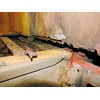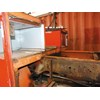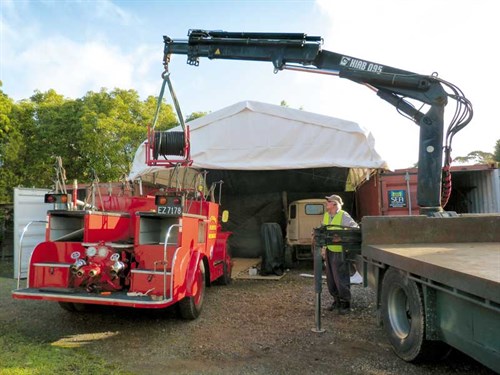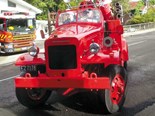1942 International fire truck restoration: part 2







|

|

|
Deals on Wheels’ latest ongoing project is the restoration of a 1942 International fire truck. Read part two in the series here.
When the deputy chief of the Titirangi Volunteer Fire Brigade asked me if I’d consider carrying out a restoration on their 1942 International fire truck, I literally jumped at the chance.
Deputy chief Evan Taylor explained that although the 73 year-old truck looked very tidy on the outside, it was showing signs of being in need of some work on its underside.
He said that the last time it was presented for a COF check, the vehicle inspectors had told him that it would soon be in need of some rust repairs if it was to continue to be driven on the road.
The brigade had been fortunate enough to be given a sizeable grant from the Portage Licensing Trust and a further donation from The Warehouse New Lynn to carry out the required work.
The old International is a regular sight on West Auckland roads especially during the lead-up to the Christmas period where it delights both young and old when its old time mudguard-mounted siren is sounded.
Once the finance for the restoration was confirmed, our small restoration team sat down on a Monday morning and started planning our methodology for carrying out the required work.
For one reason or another it was decided that yours truly would be given the lofty title of head restorer, a title which was bestowed due to the fact that I was the team member with the longest association with the iconic old truck.
As explained in part 1 of our restoration story in last month’s issue the old Inter used to be stationed at Waiatarua fire station about forty years ago when the station came under the auspices of Titirangi Brigade.
Even though Waiatarua has had quite a few fire appliances over the intervening years, I still reckon I’ve been to more fire calls on this old girl than any truck we’ve had since.
Restoration underway
Prior to starting the restoration a reasonable degree of crystal ball prognostication was needed to determine the length of time required to get the job done and we weren’t really sure at this point in time if we were going to damage the module during removal because we couldn’t see what was attached to what.
One thing we did know however was that this job was going to be quite different from taking a flat deck truck apart, as bits had been added to the machine over the past seven decades to the point where it wasn’t possible to see past each component part.
The 400 gallon tank straddled the chassis in very much the same way as pannier bags sit across a motorbike, which obscured the view of what lay within and for all we knew the chassis could have been in need of some serious reconstruction.
Compounding the lack of a decent view from underneath were a pair of lockers which had been added at some early point in the truck’s past life.
We all agreed that this wasn’t making it easy to understand how the unit had been constructed, much less how it was all going to come apart.

Fortunately for us we had on the team my good friend Dean Southey who featured in the K Bedford restoration I spoke of in the last issue.
Southey’s not one to shy away from a challenge and it didn’t take him long to get to work with an angle grinder and cutting disc to get rid of those ancillary items that were blocking our view.
After undoing as many securing nuts and bolts as we could physically see, we called in an ex Titirangi Fire Brigade chief Gordon Latham with his Hiab to lift the tank out of a very tight spot between the cab and the locker module.
It took a bit of time and a lot of patience, but by adjusting the vertical position as it was being lifted, the tank was soon swinging high above the position it had maintained for many a year.
Well done – obstacle number one had been cleared and a better view of what lay underneath was slowly being revealed.
Happily, now the tank was removed from the equation we could at last view the state of the nation and to our surprise and delight we could see that the chassis was in exceptionally good nick.
Unfortunately the same didn’t apply to the rear panel of the cab, which was badly rusted and clearly would need total replacement.
The poor state of the cab panel however was offset by the fact that we could now get a good view of the wooden-framed locker module and we could see that it was going to need less remedial work than had been previously envisaged.
Deputy Taylor AKA the Colonel had voiced concern that there was borer in the wooden frame, which was going to be difficult to replace if his prediction was correct.
He’d said that when a locker door was opened or closed, copious amounts of wood dust would fill the locker space and not one of the restorers was looking forward to replacing all that wooden framing.
As it turned out, the source of the borer dust came from the upper section of the locker doors which had been replaced at some time in the past with inferior timber.
The remedy for this malady was to unpick the metal outer part from the wooden inner, manufacture a new wooden inner part and refit the exterior to it, with tacks nonetheless.
This turned out to be a valuable lesson in coach building, an art-form that nobody on the team had encountered before.
As we’d been given a timeframe of four months to complete the restoration we were feeling very pleased with ourselves now that we’d been on the job for less that a week and we were already well underway.
Before we’d even put a spanner to the truck though, we took it into the testing station (it was due for its COF anyway) just to see what it was likely to fail on.
It turned out that the truck was fit and well mechanically except for two front tyres that would need to be replaced for the next COF.
The vehicle inspectors confirmed that it was now time to deal with a number of rust issues in the lockers and rear step.
We also paid a visit to CleanCo Truck Wash in Onehunga and gave the under-body a good steam clean, this made the dismantling job so much easier and more pleasant.
Now that we had the water tank out, the next job would be to remove the locker module and 500 gallon per minute COMOCO (Colonial Motor Company) centrifugal pump – a pretty easy job we thought.
It would be pretty easy wouldn’t it?
Follow Lyndsay's progress in the pages of Deals on Wheels magazine. Subscribe here.
Keep up to date in the industry by signing up to Deals on Wheels' free newsletter or liking us on Facebook.


.jpg)



.jpg)


.jpg)




